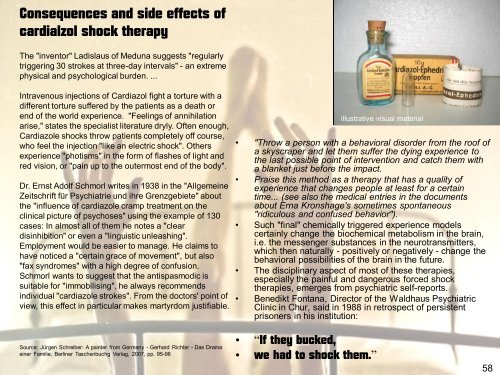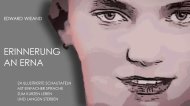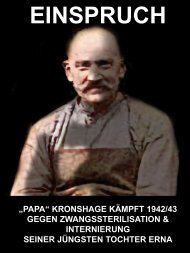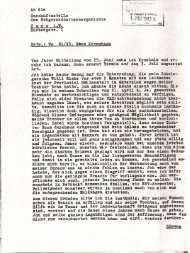ernabookXXL ENGLISH- 3.fass -
- No tags were found...
Create successful ePaper yourself
Turn your PDF publications into a flip-book with our unique Google optimized e-Paper software.
Consequences and side effects of<br />
cardialzol shock therapy<br />
The "inventor" Ladislaus of Meduna suggests "regularly<br />
triggering 30 strokes at three-day intervals" - an extreme<br />
physical and psychological burden. ...<br />
Intravenous injections of Cardiazol fight a torture with a<br />
different torture suffered by the patients as a death or<br />
end of the world experience. "Feelings of annihilation<br />
arise," states the specialist literature dryly. Often enough,<br />
Cardiazole shocks throw patients completely off course,<br />
who feel the injection "like an electric shock". Others<br />
experience "photisms" in the form of flashes of light and<br />
red vision, or "pain up to the outermost end of the body".<br />
Dr. Ernst Adolf Schmorl writes in 1938 in the "Allgemeine<br />
Zeitschrift für Psychiatrie und ihre Grenzgebiete" about<br />
the "influence of cardiazole cramp treatment on the<br />
clinical picture of psychoses" using the example of 130<br />
cases: In almost all of them he notes a "clear<br />
disinhibition" or even a "linguistic unleashing".<br />
Employment would be easier to manage. He claims to<br />
have noticed a "certain grace of movement", but also<br />
"fax syndromes" with a high degree of confusion.<br />
Schmorl wants to suggest that the antispasmodic is<br />
suitable for "immobilising", he always recommends<br />
individual "cardiazole strokes". From the doctors' point of<br />
view, this effect in particular makes martyrdom justifiable.<br />
illustrative visual material<br />
• "Throw a person with a behavioral disorder from the roof of<br />
a skyscraper and let them suffer the dying experience to<br />
the last possible point of intervention and catch them with<br />
a blanket just before the impact.<br />
• Praise this method as a therapy that has a quality of<br />
experience that changes people at least for a certain<br />
time... (see also the medical entries in the documents<br />
about Erna Kronshage's sometimes spontaneous<br />
"ridiculous and confused behavior").<br />
• Such "final" chemically triggered experience models<br />
certainly change the biochemical metabolism in the brain,<br />
i.e. the messenger substances in the neurotransmitters,<br />
which then naturally - positively or negatively - change the<br />
behavioral possibilities of the brain in the future.<br />
• The disciplinary aspect of most of these therapies,<br />
especially the painful and dangerous forced shock<br />
therapies, emerges from psychiatric self-reports.<br />
• Benedikt Fontana, Director of the Waldhaus Psychiatric<br />
Clinic in Chur, said in 1988 in retrospect of persistent<br />
prisoners in his institution:<br />
Source: Jürgen Schreiber: A painter from Germany - Gerhard Richter - Das Drama<br />
einer Familie, Berliner Taschenbuchg Verlag, 2007, pp. 95-96<br />
• “If they bucked,<br />
• we had to shock them.”<br />
58


















